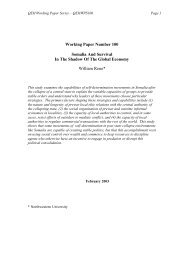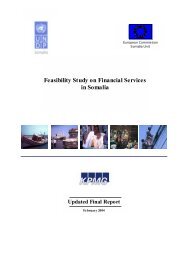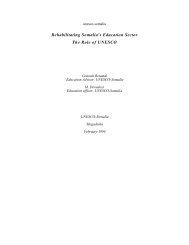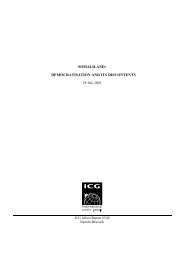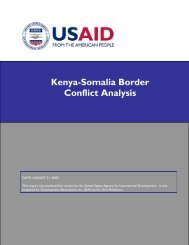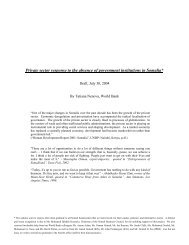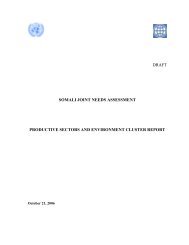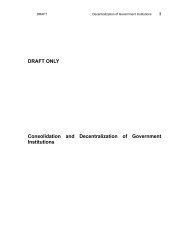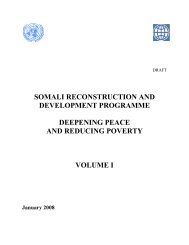Primary Education Survey Evaluation Report Somalia - Somali - JNA
Primary Education Survey Evaluation Report Somalia - Somali - JNA
Primary Education Survey Evaluation Report Somalia - Somali - JNA
You also want an ePaper? Increase the reach of your titles
YUMPU automatically turns print PDFs into web optimized ePapers that Google loves.
PES <strong>Evaluation</strong> <strong>Report</strong>, 2008<br />
1.2 Recommendations<br />
a. That expansion of the data collected take place to provide for a full set of EFA and MDG<br />
indicators.<br />
b. That systematic recording of school outcome data should be undertaken to facilitate judgments<br />
about school quality.<br />
c. That a criterion referenced approach to school outcomes be adopted that allows the recording of<br />
the percentage of students who have achieved a set of defined outcomes.<br />
d. That the number of grade 1 enrolments who have attended Qur’anic school and ECD be recorded.<br />
e. That Qur’anic status of Qur’anic schools offering an integrated hybrid curriculum be recorded.<br />
f. That a more precise analysis of out of school children be undertaken to investigate the underlying<br />
issues of out of school children. This should be a study separate from the EMIS.<br />
g. That school condition data be collected with the caveat that it will need to be interpreted with<br />
caution.<br />
h. That proxy indicators such as lesson types used regularly, or use of corporal punishment in last<br />
month that reflect degree of child friendliness be considered.<br />
i. That some key resources that are commonly available and for which there is money or a donor<br />
ready to provide be recorded.<br />
j. That the data collected include an expanded view of non-formal curriculum components.<br />
k. That a data on emergency risk and emergency preparedness be considered.<br />
l. That the priority list for data expansion be adopted.<br />
m. That NGOs and other agencies be given regular opportunities to contribute to the data design<br />
process.<br />
2 <strong>Report</strong>ing<br />
2.1 Findings and Analysis<br />
In this section comment will be made with regard to two separate aspects of reporting. The first is<br />
comment with regard to the Draft report from the 2006/2007 survey, which has not as yet been published.<br />
The second draws upon findings with regard to the use of the Data and the EMIS conceptual framework<br />
that indicated the EMIS is a process that requires movement of information both up and down within the<br />
system. A significant development this year has been the use of Access data base to store the data. This<br />
will improve flexibility and accessibility for investigating emerging issues and challenges. More comment<br />
on the potential of this data base in made below, but first the draft 2006/7 report is considered.<br />
The nature of reporting from the survey has been explored. The draft PES report that has been analysed<br />
seems to be opaque, poorly constructed and contains many inaccuracies. These inaccuracies have<br />
occurred in the extraction of data from the data base and in the subsequent analysis. A few of the<br />
apparent errors are listed here to illustrate the point.<br />
• Paginations are not consistent with contents table<br />
• Headings of unnumbered tables on pages 19 to 23 refer to the wrong year<br />
• Total enrolment figure for North West region on page 19 is 124117. It should be 115999. 115999<br />
is used elsewhere in the report and is consistent with the data in the Access data base.<br />
• The difference above leads to inconsistent reporting of total enrolment figures across the report<br />
(392101 versus 383983).<br />
• Annex 7 uses a total enrolment of 318159, when a check reveals it should be 383983. (An earlier<br />
version of annex 7 which had some major inaccuracies has, fortunately, been extensively<br />
modified in the current draft of the report)<br />
• Percentage change figures are sometimes incorrect or do not use a negative sign to differentiate<br />
between directions of change<br />
• Gross Intake Ratio is inappropriately defined<br />
• Survival rates are not consistent with EFA definitions<br />
32



